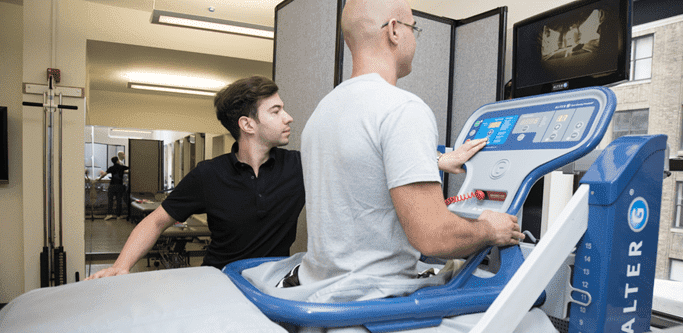June 26, 2024

Likely as a result of continuous running and cutting while playing field hockey, a 25 year-old female experienced a plantar fascia tear. The tear was discovered via diagnostic imagining after the athlete had been suffering from painful plantar fasciitis for approximately six months.
After undergoing surgery in order to gait recovery and the neuromuscular training necessary for proprioception. The athlete began post-operative rehabilitation with the following basic goals:
The athlete received traditional rehabilitation therapy that included therapeutic movement, mobilization of joints, and NSAIDs.
While receiving this therapy, she began the additional conditioning program that included workouts on the Anti-Gravity Treadmill. This four-phase program began in the fifth week after surgery and was scheduled for 10 weeks.
Full weight bearing began in phase one, along with beginning work on range of motion, gait re-education, pain management, and proprioception.
From weeks seven through nine, this phase continued the work from phase one and initiated a beginning cardiovascular training regimen. Additionally, phase two began to increase:
Phase three continued the work of phases one and two, including increases in volume and intensity.
This phase also decreased the angle of the surface on the Anti-Gravity Treadmill and initiated a full foot strike.
From weeks 13 through 15 after surgery, phase four maintained levels of volume and conditioning along with the same angle of surface from phase three. However, load was increased, and work to sports activity during this phase.
Feedback from the athlete was important to determine the speed of the treadmill workouts as well as the force of the impact the athlete would endure with each foot strike.
The rehabilitation program was successfully completed on schedule, and the athlete was given a green light by her physician to manage her gait and increase impact incrementally as pain levels allowed.
Four weeks after completion of the combined programs, the athlete returned to use the Anti-Gravity Treadmill in conjunction with her normal conditioning program.
Dr. Lev Kalika is a world-recognized expert in musculoskeletal medicine. with 20+ years of clinical experience in diagnostic musculoskeletal ultrasonography, rehabilitative sports medicine and conservative orthopedics. In addition to operating his clinical practice in Manhattan, he regularly publishes peer-reviewed research on ultrasound-guided therapies and procedures. He serves as a peer reviewer for Springer Nature.
Dr. Kalika is an esteemed member of multiple professional organizations, including: